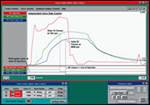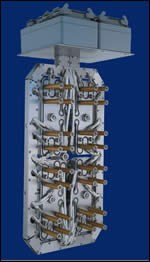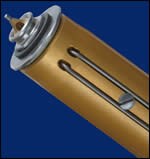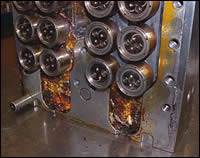Evaluating Gate System Designs
A hybrid gating option combines the advantages of valve gate and thermal gate systems.
Many hot runner suppliers have contributed much to the plastics industry—providing process and commercial benefits that otherwise could not be realized. Up until now all hot runner systems were provided in two versions: thermal gate or valve gate system designs.
Thermal Gate
The first to enter the market and still the most common are thermally operated. These systems fill and pack injection mold cavities by opening (due to plastic pressure) and closing (freezing of the gate) each gate by a delicate balance of material temperature and injection pressure. Thermal designs are often selected for very high cavity count molds—such as those found in the medical disposable, packaging and closure markets. These molds are designed with very close cavity pitch dimensions. Thus the ability to control the balance between the temperature of each gate area and of the hot runner nozzle is often challenging.
To accomplish necessary simultaneous gate opening, thermal systems require the operator to balance or fine tune each hot runner nozzle temperature according to the mold environment by means of a temperature control device.
In a typical 64-cavity mold it is not uncommon for the nozzle temperatures set-points to vary up to 50+ degrees Fahrenheit in order to ensure gate opening occurs simultaneously. Since the highest temperature set-point determines the cooling phase in the overall cycle, inconsistent gate opening directly affects the difference between profit and loss in these markets.
Valve Gate
Valve gate systems, the alternate solution, offer injection molders increased flexibility and process opportunities that cannot be achieved with the use of thermal gate systems. Typical valve gate systems are operated by either pneumatic or hydraulic cylinder mechanisms attached to hot runner nozzle pins that then open and close the gate area controlling the fill and pack of the injection molded part.
The automotive and electronics markets are examples where these specialized processes are necessary and include sequential, independent, and alternate fill and pack, as well as predictable gate opening and closing. The elimination of weld lines in single-cavity, multi-gated molds can only be achieved with the use of hot runner valve gate systems by cascading the filling and final pack. Backmolding—or the process of applying molten plastic to a fabric or other material—is another area where valve gate systems are necessary to achieve the cosmetic requirements of the customer.
Valve gate systems provide the optimum in cosmetic gate performance and also are necessary to stop drooling of molten plastic in vertical injection molding operation; yet, with all the advantages provided by their use, the vast majority of hot runner systems sold are still thermally operated.
Most of the time initial cost will be the determining factor for the thermal gate selection, and often the molder will forego the process benefits that can be realized with the use of valve gate designs.
Control Gate
This year an innovative solution offering the advantage of predictable and consistent gate opening found in typical valve gate applications, but at a price nearer to that of a comparable thermal gate system was introduced at NPE.
Control gate systems are really a hybrid design. The cylinder/piston device is similar to a valve gate where open and close of gates is directly controlled, but the new control gate system is operated mechanically through the use of compression disc washers and pneumatic pressure.
Pneumatic pressure is applied on the full surface area of the control gate piston moving the control gate pin forward thus closing the gate and at the same time compresses the disc washer. At the beginning of filling, pneumatic pressure is released on the piston causing the disc washers to relax and thereby retracting the control gate pin and allowing for all gates to open simultaneously.
Fast cycle molding operations can quickly realize improvements in the same way as provided with typical valve gate systems. Opening of all gates on the control gate system is mechanically operated, ensuring simultaneous fill time consistency as well as eliminating molding environment control over gate opening and at a price significantly less than that of a standard valve gate system.
Insert molding applications using a vertical clamp injection molding machine now have an economical solution compared with a full valve gate system since the control gate can eliminate the opportunity for drool due to gravity and decompression through the gate during mold open.
Valve gate systems still maintain their important place in the market as the system of choice where gate cosmetics are the deciding factor or where special processes such as cascade or two-shot over-molding is required. Control gate systems provide injection molders and mold manufacturers versatility and cost savings opportunities where a mechanical function of the gate is required.
Related Content
Fundamentals of Designing the Optimal Cooling System
The right mold components can help improve mold cooling and thereby produce higher-quality parts.
Read MoreTreatment and Disposal of Used Metalworking Fluids
With greater emphasis on fluid longevity and fluid recycling, it is important to remember that water-based metalworking fluids are “consumable” and have a finite life.
Read MoreThe Ins and Outs of Hot Runner Temperature Control
A training checklist that explains the why and how of proper hot runner temperature control and system management.
Read MoreRevisiting Some Hot Runner Fundamentals
What exactly does a hot runner do? If you’ve been in the injection molding industry for any length of time, you might think the answer is obvious, but it is not.
Read MoreRead Next
Part One of a Two-Part Series Valve Gate Sequencing Strategies
Ways to use valve gate control strategies to improve quality, efficiency and profitability
Read MorePart Two of a Two-Part Series Valve Gate Sequencing Strategies
More valve gate strategies and how they help moldmakers and molders work together to develop a mold that will provide the most consistent performance.
Read MoreCleaning a Flashed Hot Manifold, Part One
A look at in-house and outsourced cleaning.
Read More










.jpg;maxWidth=300;quality=90)













